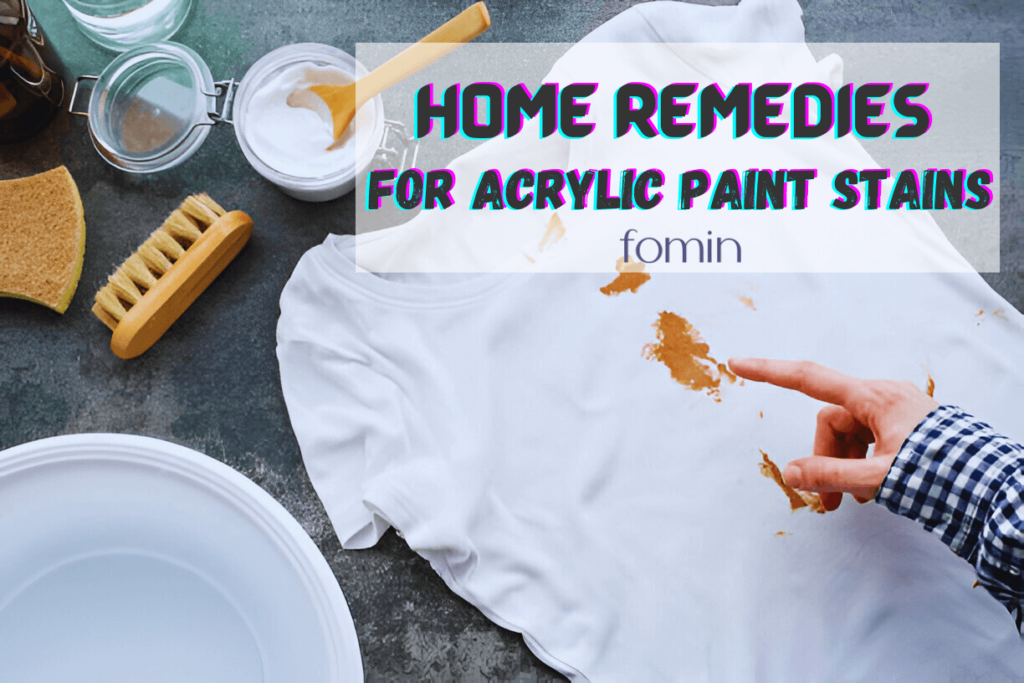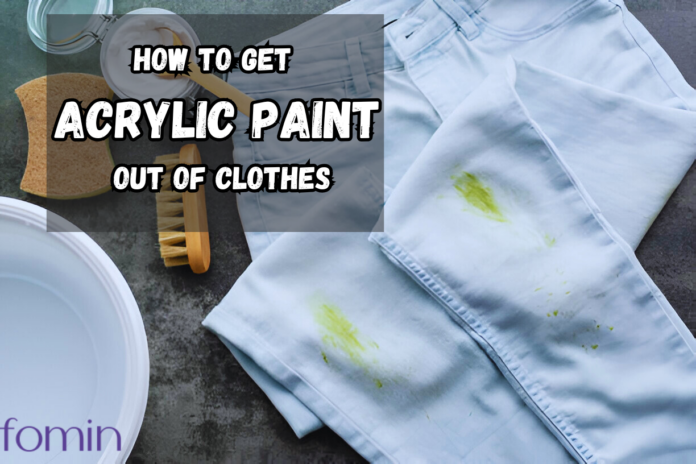Acrylic paint is a favorite for artists and DIY enthusiasts. Its vibrant colors and quick-drying properties make it perfect for creating stunning artwork and fun crafts. But when this paint accidentally spills onto your favorite clothes, it can be a disaster. Don’t worry though; there’s hope! Whether the stain is fresh or dried, you can save your garment with the right approach.
This ultimate guide will show you how to remove acrylic paint from all fabric types, from cotton to silk, and even upholstery. By the end, you’ll be equipped with practical tips, step-by-step methods, and the best products to ensure your clothes remain as good as new—even after an acrylic paint mishap.
Why Acrylic Paint Stains Are Tough to Remove
Before we dive into how to get rid of acrylic paint stains, it’s important to understand why they can be so tough to remove.
What Makes Acrylic Paint Different?
Acrylic paint is made up of pigment, water, and acrylic polymer. The paint forms a bond with fabric fibers when it dries, which creates a durable and somewhat waterproof layer. Unlike watercolor paints, which dissolve with water, acrylics resist moisture once they’ve set. This is why acrylic paint stains are more stubborn than others.
The Science Behind Acrylic Paint
When acrylic paint dries, it becomes water-resistant and hardens into a flexible plastic-like film. This bond is one of the reasons why dried acrylic paint stains can seem almost impossible to remove. If you act quickly while the paint is still wet, the chances of complete removal are much higher.
Understanding how the paint behaves will guide you in choosing the best stain-removal techniques.

Immediate Action: How to Handle Fresh Acrylic Paint Stains
If you’ve just spilled acrylic paint on your clothes, don’t panic! The faster you act, the better your chances of removing the stain completely. Here’s what you should do as soon as you notice the stain:
- Scrape Off Excess Paint:
- Use a dull knife or spoon to gently remove as much paint as possible without pushing it deeper into the fabric.
- Be careful not to spread the paint to other areas of the garment.
- Blot, Don’t Rub:
- Use a clean cloth or paper towel to blot the stain. Avoid rubbing, as this can spread the paint further and push it deeper into the fabric.
- Rinse with Cold Water:
- Hold the stained fabric under cold running water, ideally from the back of the fabric to help push the paint out, not further in.
- Apply Dish Soap or Laundry Detergent:
- Apply a small amount of dish soap directly to the stain. Gently rub it in with your fingers or a soft-bristle brush to break down the paint.
- Repeat the Process:
- Keep rinsing and reapplying soap until you can see that the paint is lifting from the fabric.
- Wash the Garment:
- After treating the stain, wash the garment according to its care label instructions. Be sure to check that the stain is completely gone before putting it in the dryer, as heat can set the stain.
How to Remove Dried Acrylic Paint Stains
When acrylic paint dries, it becomes more difficult to remove. But don’t worry—while it’s a tougher job, it’s still manageable. Here’s how to tackle dried acrylic paint stains:
1. Loosen the Dried Paint
- Soak in Warm Soapy Water:
- If the paint is only slightly dried, soak the garment in warm water with a bit of dish soap for 30–60 minutes to soften the paint.
- For thicker stains, gently scrape off as much paint as possible using a butter knife or credit card.
- For Thicker Stains:
- If the stain remains stubborn, you can apply a solvent like isopropyl alcohol or acetone to break down the acrylic. Be sure to test these solvents on an inconspicuous area of the fabric to ensure they don’t cause damage.
2. Apply a Paint Remover or Solvent
- Rubbing Alcohol or Acetone:
- Dampen a cloth with rubbing alcohol or acetone and blot the stained area. For acetone, be cautious with synthetic fabrics like polyester, as it can damage them. Always test in a hidden spot first.
- Fabric-Safe Solvents:
- Commercial fabric-safe paint removers can also be effective. Just follow the instructions carefully.
3. Scrub the Stain
- Use a Soft Brush:
- Once you’ve applied the solvent, use a toothbrush or small brush to gently scrub the stained area. This helps lift the paint from the fabric fibers.
4. Rinse and Wash the Garment
- Rinse Thoroughly:
- Rinse the fabric under cold water to remove any remaining paint and solvent. Once the stain is gone, wash the garment according to the care label instructions. Be sure to check the fabric after washing before drying.

Home Remedies for Acrylic Paint Stains
If you prefer a more natural approach to stain removal, several home remedies can work effectively. Here are a few DIY solutions:
1. Vinegar and Baking Soda
- How to Use:
- Mix equal parts vinegar and baking soda to form a paste. Apply this paste to the stained area and let it sit for about 15–20 minutes. Afterward, scrub the area with a toothbrush and rinse.
2. Hairspray
- How to Use:
- Spray the paint stain with a generous amount of hairspray. Let it sit for 5–10 minutes before blotting the stain with a clean cloth. The alcohol in the hairspray can help break down the paint.
3. Milk Soak
- How to Use:
- For stubborn stains, soak the fabric in milk overnight. This can help loosen the paint and make it easier to wash out the next day.
4. Dish Soap and Baking Soda
- How to Use:
- Combine dish soap with baking soda to create a paste. Apply the paste to the stain, scrub it gently, then rinse with cold water.
Fabric-Specific Guidelines: How to Handle Different Fabrics
Each fabric type reacts differently to stain treatments, so it’s essential to approach each one with the proper care.
Cotton and Polyester
- These durable fabrics can withstand soaking and scrubbing, so you can be more aggressive with your cleaning methods. Use warm water for cotton and test solvents for polyester before applying them.
Silk and Wool
- Use gentler methods for delicate fabrics like silk and wool. Stick to cold water and mild dish soap. Avoid using solvents that may cause fabric damage.
Denim and Canvas
- Denim is durable and can handle scrubbing with a stiff brush. For thicker stains, try using acetone or rubbing alcohol, but test it first on a hidden part of the fabric.
Upholstery and Carpets
- Upholstery and carpets require a more gentle touch. Blot the stain using a damp cloth, then apply a cleaning solution of dish soap and warm water. Rinse the area by blotting it with fresh water.
When to Seek Professional Help
If you’ve tried everything and the stain remains, it might be time to consult a professional cleaner. Dry cleaning is especially useful for delicate fabrics like silk, wool, and velvet.
Dry Cleaning:
- Ideal for tough stains on expensive or delicate fabrics, dry cleaning can often remove acrylic paint without damaging the material.
Steam Cleaning:
- Steam cleaning can be another great option for stubborn paint stains. It loosens the paint and makes it easier to blot away.
Preventing Acrylic Paint Stains in the Future
The best way to deal with acrylic paint stains is to prevent them from happening in the first place. Here are some prevention tips:
- Wear Protective Clothing:
- Always wear old clothes or a smock when working with acrylic paints. This reduces the risk of staining your favorite outfits.
- Protect Your Work Area:
- Lay down plastic sheets or old newspapers to catch any splashes or spills.
- Use Fabric Protectors:
- Consider applying a fabric protector like Scotchgard to prevent paint from penetrating the fabric in the first place.
Frequently Asked Questions (FAQs)
Can I use bleach to remove acrylic paint?
- Bleach is not effective for acrylic paint and can damage your clothing. It’s best to stick with solvents or home remedies.
How do I know if the paint has completely come out?
- After washing, check the stained area before putting the fabric in the dryer. The heat can set any remaining paint, making it much harder to remove.
What should I do if the paint is still visible after washing?
- If the stain persists, try applying a solvent again and rewash the garment. Sometimes stubborn stains need multiple attempts.
Conclusion
Removing acrylic paint from clothes doesn’t have to be a stressful task. Whether the stain is fresh or dried, you now have a range of methods to choose from. From simple home remedies to professional solutions, you can confidently tackle paint stains on any fabric. The key is acting quickly and using the right technique for the type of stain and fabric you’re dealing with.
By following the step-by-step instructions we’ve outlined, you can save your clothes from permanent damage and restore them to their original state. With the right tools and products at your disposal, you’ll be ready for any future painting projects without worrying about ruining your wardrobe.
Remember, prevention is always better than cure. By taking a few precautions while working with acrylic paints, you can avoid stains altogether. However, if accidents do happen, you now know exactly what to do to get your clothes looking clean and fresh once again.
